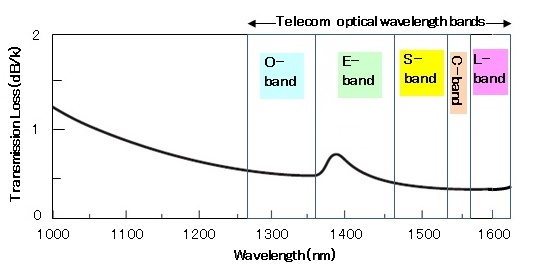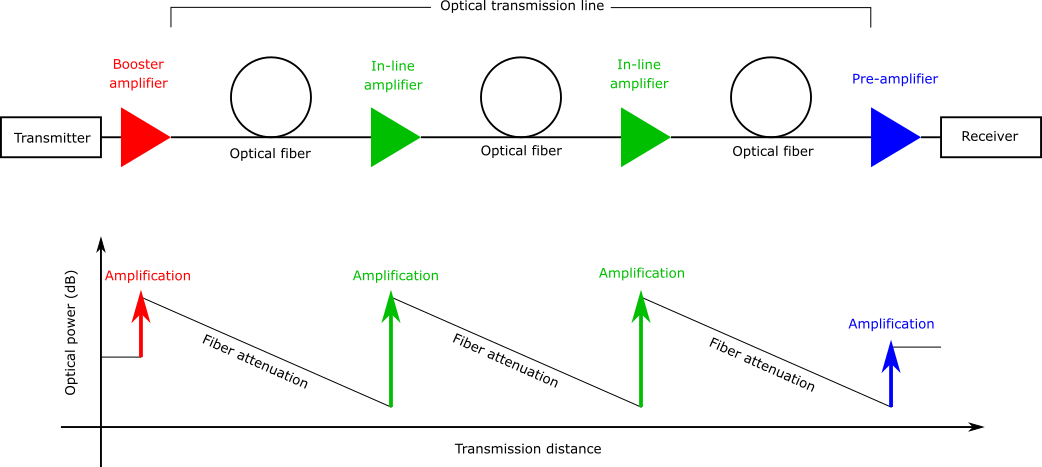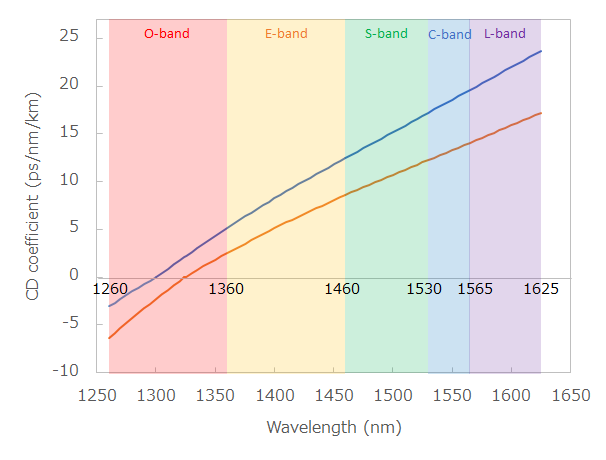JAPANESE / ENGLISH

JAPANESE / ENGLISH
Last updated on 05/7/2021
The C-band, ranging from 1530 nm to 1565 nm, stands for the conventional band (see Figure 1). It is the primary wavelength band used for optical communication especially in a long-distance (i.e. inter-continental and trans-oceanic) transmission system, because the attenuation of optical fiber has its minimum in the C-band. The current lowest loss of optical fiber is 0.1419 dB/km at 1560 nm, which was reported in 2017 .

Figure 1: O/E/S/C/L-bands
Another important factor, that has made the C-band the primary wavelength band for optical communication, is the invention of erbium-doped fiber amplifier (EDFA). An EDFA enables high-gain optical amplification with low noise, and has enabled long-distance optical transmission without using an O-E (optical-to-electronic) and E-O converter.

Figure 2: EDFAs used in optical transmission system
The conventional single-mode fiber possesses a chromatic dispersion coefficient of around 15-17 ps/nm/km in the C-band (see Figure 3), and chromatic dispersion compensation is necessary for high-speed and long-distance transmission systems. Optical dispersion compensation devices, such as dispersion compensation fibers and fiber Bragg gratings, have long been used in an intensity-modulated, direct-detection (IM-DD) transmission systems.

Figure 3: Chromatic dispersion (CD) characteristics of conventional single-mode fiber (G.652.D ), showing five optical transmission bands and max/min CD coefficients.
Digital-coherent detection has now become common in many state-of-the-art, long-haul and submarine optical transmission systems. In a digital-coherent detection system, the signal is sent by changing the phase of light, and is detected by measuring the phase. The phase modulation/detection allows electronic dispersion compensation using a digital signal processor (DSP), and optical dispersion compensation devices can be eliminated from the system.
Now optical communication using the C-band has become very mature, and demand for further transmission capacity increase never ends. In order to meet such capacity demand, optical transmission using the L-band has been considered and now is commertially available. Even DWDM transmission in the S-band has attracted attention in R&D stage.
FiberLabs offers the following products related to this article. Please visit these pages if you are interested in this article.
| C-band | C+L-band | S+C+L-band | Full-band | |
|---|---|---|---|---|
| Fiber amplifier | Bench-top Bench-top, HP Rack-mount OEM Module | Bench-top 4-λ CWDM (rack-mount) Unidirectional BiDi, Booster BiDi, In-line | 8-λ CWDM (rack-mount) Unidirectional | N/A |
| ASE source | Bench-top OEM module | Bench-top OEM module | Bench-top | N/A |
| SLD source | Bench-top OEM module | Bench-top | Bench-top | Bench-top |
| LD source | Bench-top (Fabry-Perot) Bench-top (DFB) Bench-top (FBG-stabilized) | N/A | N/A | N/A |
| Tunable filter | Bench-top | Bench-top | N/A | N/A |